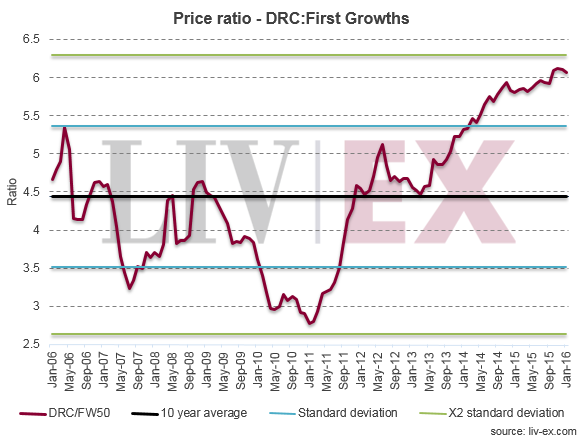
Market speculation as to whether DRC prices are overstretched has been rife for some time now, but so far the speculation has failed to become a reality. DRC prices have made impressive gains in recent years, while Bordeaux prices have largely stuttered. The Liv-ex Fine Wine 50 index has fallen around 40% since its peak in 2011. Over the same period, the DRC index (composed of the DRC’s six brands) rose 10.9%. Over a ten-year period, the DRC index has increased 285% compared to an overall gain of 144% for the Liv-ex 50.
The chart above shows the historical relationship between the average prices of the wines in the Liv-ex Fine Wine 50 and the DRC Index – dividing one by the other to create a ratio.
As shown, the ten-year average is 4.4:1 and the DRC:First Growth ratio has held above this level since December 2011, reaching a high of 6.11: 1 in November 2015. The recent high was 1.83 standard deviations from the mean average for the ten-year period.
It is interesting to observe that on the flipside, the DRC:First Growth ratio bottomed out at -1.82 standard deviations below the mean average for the ten-year period.
While this alone may not be conclusive evidence to support recent market speculation that DRC prices may have peaked, it does at least add some weight to the argument that it might be time to take a closer look at the relative value of the First Growths.
Given that over the longer-term, ratios tend to revert to the mean, a switch in portfolio weightings might be just the tonic for those lucky enough to have such a portfolio…
More on this topic: Cellar Watch subscribers can find analysis on the price differences between the First Growths – the top tier wines – from a number of different regions in the February market report.
[mc4wp_form id=”18204″]




